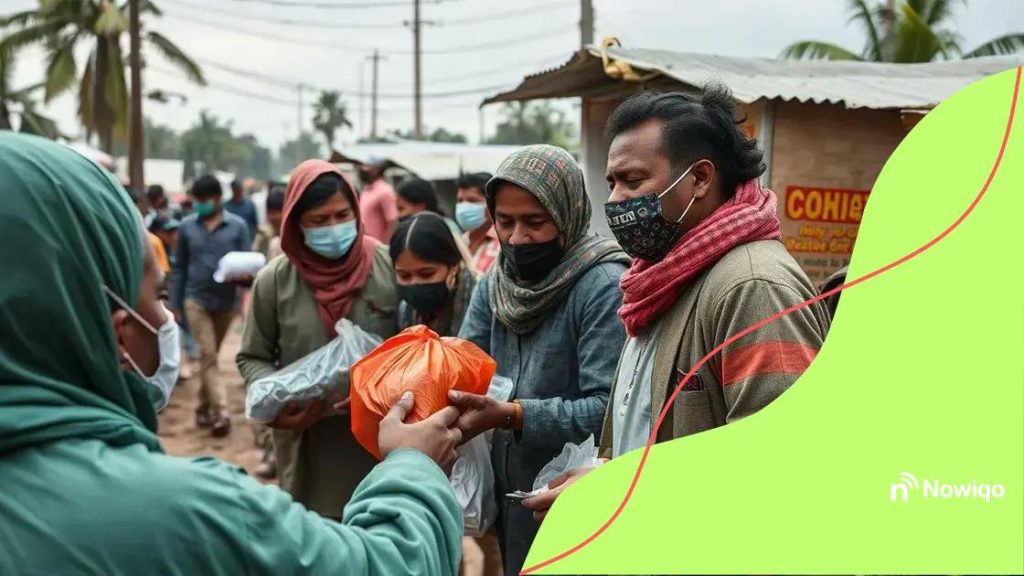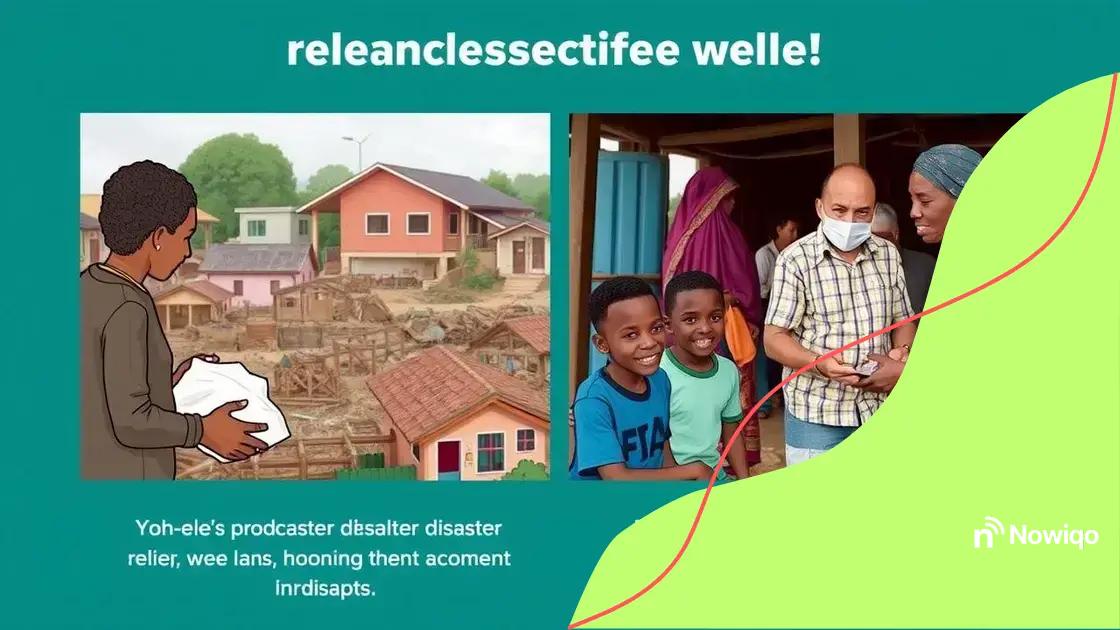Disaster relief fund updates: How Aid is Changing Lives

Anúncios
Disaster relief fund updates showcase how organizations allocate resources and engage communities to enhance response efforts, utilizing technology and local knowledge for effective recovery from emergencies.
Disaster relief fund updates provide crucial insights into how communities are recovering from crises. Many wonder how funds are used and the impact they create. Join us as we explore the latest developments and inspiring stories.
Anúncios
Current disaster relief fund status
The current disaster relief fund status is crucial for understanding how resources are allocated during emergencies. Many communities rely on these funds to rebuild and recover. Tracking how funds are used helps create transparency and ensures that aid reaches those in need.
Overview of Funding Sources
Disaster relief funding comes from various sources, including government agencies, non-profit organizations, and private donations. Each source has its process for distributing funds, which can impact how quickly aid reaches affected areas.
- Government grants and budgets
- Non-profit organization contributions
- Individual fundraising efforts
- Corporate donations and sponsorships
Understanding these funding sources is key to knowing where the resources are coming from and how they may be spent. Every dollar counts in emergency situations, and quick access to funds can significantly affect the recovery process.
Anúncios
Current Allocation of Funds
As of now, many organizations are actively distributing funds to support ongoing recovery efforts. It’s important to note how funds are being allocated:
- Emergency shelter and basic needs
- Health care and medical supplies
- Building and infrastructure repairs
- Psychological support services
Each allocation aims to address immediate needs while also considering long-term recovery. The status of these funds can change as new disasters occur or as recovery progresses.
Transparency in the current disaster relief fund status helps keep donors informed so they can see the positive impact their contributions are making. Regular updates allow communities to witness the changes being implemented and the lives being transformed as a result.
How funds are allocated and used
Understanding how funds are allocated and used during disaster relief efforts is essential. The process ensures that aid reaches the individuals and communities that need it most. Different organizations have various methods for distributing these funds effectively and transparently.
Allocation Process
Funds are typically allocated based on pressing needs identified by local assessments. This process may involve:
- Evaluating the immediate requirements of affected communities
- Collaborating with local agencies and officials
- Prioritizing areas in critical distress
- Regularly updating resource needs as situations evolve
The allocation process helps ensure that the right amount of support is provided quickly. Utilizing local knowledge enhances the effectiveness of fund usage.
Utilization of Funds
Once allocated, the utilization of funds can take many forms. Some key areas include:
- Providing essential supplies like food, water, and medical care
- Funding long-term recovery projects, such as rebuilding homes and infrastructure
- Offering support services like mental health counseling
- Investing in disaster preparedness for future events
Each of these areas highlights the different ways that donations can create real impact. When funds are used effectively, they not only meet immediate needs but also set the foundation for lasting recovery.
Awareness of how funds are allocated and used can encourage more donations. Potential donors often prefer to see tangible results from their contributions, fostering a culture of trust. This trust is vital for ensuring ongoing support in the future.
Real-life impacts of disaster relief

The real-life impacts of disaster relief can be seen across communities that have faced devastating events. As funds and aid flow into these areas, they transform lives and help rebuild futures. Understanding these impacts sheds light on the importance of disaster relief work.
Impact on Individuals
For many individuals, disaster relief means immediate access to essentials like food, water, and shelter. This assistance can be lifesaving. Individuals who receive support often express a renewed sense of hope and recovery:
- Access to medical care and psychological support
- Reconnection with family and community resources
- Opportunities for a better future
These impacts highlight how critical disaster relief efforts are to personal well-being. They also encourage resilience among survivors.
Community Rebuilding
The broader community benefits from collective recovery efforts. For instance, rebuilding infrastructure plays a significant role in restoring normalcy:
- Repairing roads and bridges for better connectivity
- Reestablishing schools and health centers
- Supporting local businesses to encourage economic growth
These rebuilding initiatives foster a sense of unity and collaboration within communities, enabling them to recover together.
Moreover, the real-life impacts of disaster relief extend beyond immediate needs. They create lasting change, helping communities develop better preparedness for future disasters. Learning from challenges helps foster stronger, more resilient societies.
Community involvement in recovery efforts
Community involvement in recovery efforts plays a critical role in making disaster relief successful. When local individuals participate in recovery, their unique knowledge and experiences guide the process. This active participation fosters a sense of ownership and pride among residents.
Ways Communities Get Involved
Communities can engage in various ways during recovery efforts. Some of the most impactful methods include:
- Organizing local fundraising events to support relief initiatives
- Volunteering time and skills to assist in rebuilding efforts
- Creating support networks for those affected by disasters
- Collaborating with organizations for resource distribution
Through these methods, community members contribute to a stronger collective response. Their involvement ensures that recovery aligns with local needs and conditions.
Importance of Local Knowledge
Local knowledge is invaluable during recovery. Community members understand their environment better than anyone else. They know the specific challenges their neighbors face, making their feedback essential:
- Identifying areas most in need of support
- Sharing insights about vulnerable populations
- Helping plan effective recovery strategies
This understanding leads to more efficient use of resources and more effective recovery efforts. Additionally, community involvement often encourages a spirit of collaboration among different groups, including local authorities and organizations.
Ultimately, the importance of community involvement in recovery efforts cannot be overstated. It not only enhances the effectiveness of disaster response but also promotes resilience, ensuring communities can stand strong in the face of future challenges.
Future of disaster relief initiatives
The future of disaster relief initiatives is evolving as new technologies and strategies emerge. Organizations are rethinking how they respond to disasters, aiming for more efficient and impactful solutions. Understanding these trends can help communities prepare better for future crises.
Technological Advancements
One major area shaping the future of disaster relief is technology. Innovations improve both response times and coordination among volunteers. Some key advancements include:
- Using drones for assessing damage and delivering supplies
- Implementing mobile apps for easier communication and resource tracking
- Utilizing social media for real-time updates and community engagement
- Incorporating big data to analyze trends and predict future needs
These technologies enable quicker and more effective responses, ultimately saving lives and resources.
Community-Centered Approaches
Another important trend is a stronger focus on community involvement. Engaging local populations leads to more tailored responses. This shift emphasizes:
- Training community members in emergency preparedness
- Prioritizing local knowledge in relief planning
- Fostering partnerships between organizations and local groups
- Encouraging volunteerism in recovery efforts
By involving the community, disaster relief becomes more relevant and impactful. People are often more receptive to aid efforts when they feel a sense of ownership.
As we look ahead, the future of disaster relief initiatives will likely include a blend of cutting-edge technology and grassroots community efforts. This combination aims not only to respond effectively but also to build resilience against future disasters, ensuring that communities are better prepared.
FAQ – Frequently Asked Questions about Disaster Relief Initiatives
What is disaster relief?
Disaster relief refers to the assistance provided to help individuals and communities recover from emergencies and crises, such as natural disasters.
How do organizations determine where to send aid?
Organizations assess the affected areas by evaluating the immediate needs of communities, working closely with local authorities and teams on the ground.
What role does technology play in disaster relief?
Technology helps improve response times and coordination among volunteers, using tools such as drones, mobile apps, and data analysis for effective aid distribution.
How can individuals get involved in disaster relief efforts?
Individuals can participate by volunteering, fundraising, or collaborating with local organizations to support recovery efforts in their communities.